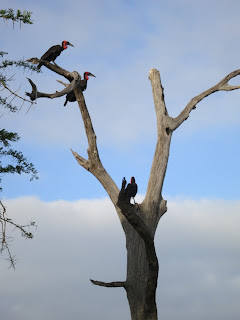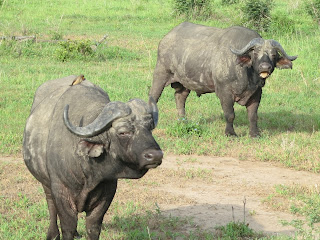Although I've left my childhood long
behind me, and my dream of studying animals for a living along with
it, I still hold a powerful appreciation for the natural world and
the wild things which inhabit it. That is why when Jenna and I had
the opportunity to explore another of Africa's National Parks, we had
to jump on the chance. After all, who knows when we'll be back
again?
Jenna and I left Mbeya and the
wonderful people at The Olive Branch for Children a few days ago. We
decided we would take a bus to Mikumi—a small town which shares its
name with the natural park it borders—and spend two nights there.
We hired a guide who had been recommended by a friend at The Olive Branch to drive us into the park and spent a full day with
him.
Mikumi National Park, at 3230 square
kilometers, is the fourth largest national park in Tanzania. It
borders the Selous Game Reserve, and many animals found in the
park regularly migrate to and from that region. Most of the park is
characterized by savannah, and is home to a variety of the typical
large mammals of that ecosystem in Africa: zebras, giraffes,
elephants, warthogs, wildebeests, etc. Mikumi did not disappoint,
and we found ourselves face to face with many of the animals that had
inspired my childhood fantasies. While I had seen many of the
animals before, in zoos, there is something altogether different and
much more special about seeing such animals in the wild, in such
large numbers.
 |
| Mohammed called this a "whiska" (I am unsure of how to spell it!) |
We started the safari very early in
the morning. Our guide, Mohammed, picked us up from our hotel at
6:00 am, and we found ourselves setting off as the sun was rising.
This, Mohammed said, was the best time to observe some of the
hundreds of varieties of birds that populate the area. He proved
right, and as we began our day, we were greeted by dozens of different
species. The birds we encountered included the amazingly ugly
marabou stork (an omnivore with a bald, fleshy head), ground hornbills, a
spooky-looking owl (apparently feared as a harbinger of death by some
locals), and the appropriately-named superb starling (incredibly
vibrant with glossy blue, red and yellow feathers).
 |
| A trio of ground hornbills |
 |
| For lack of it's proper name, I'll call this one an "Angry Bird" |
 |
| The not-so-pleasant-to-behold marabou stork |
Besides birds, we soon learned that
the park held a plethora of larger beasts, and we set eyes upon
countless giraffes and zebras. We also encountered a few groups of
elephants, some water buffalos and a group of Hippos keeping cool in a pond. A rare sighting was a couple of black-backed foxes keeping a wary distance from our
vehicle. A particularly special sight was one pair of giraffes, a
male and a female, putting on what seemed to Jenna and I a display of
flirtation. One giraffe would swing its long neck around and knock the
other's flank with their head. Then the other would reciprocate.
This lasted quite a few minutes, and the display reminded us of a game that lovestruck teenagers might play.
 |
| A family of giraffes chowing on their favorite, acacia leaves |
Throughout the day, Jenna and I were both keeping a watchful eye out for an animal neither of us had seen in the wild. As the day wore on, we were beginning to doubt whether we would get the chance to see one before we had to pack up and head home. It was approaching late afternoon, and our time in the park was rapidly diminishing. Luckily, Mohammed's trained eyes spotted two of these beautiful creatures resting in the shade of a nearby tree. They were two lionesses, and they were far enough away that we would have passed them by without our guide. They gave us a disinterested glance as we passed, stretched, and continued their afternoon nap. Hours later, as we were returning to the park entrance, these two were exactly where we left them, resting up during the heat of the day to prepare for the night's hunt.
 |
| Can you spot the lionesses? |

 |
| Myself and our guide, Mohammed, next to an enormous Baobab tree |
We watched the sun rise and set in the park, and the entire day was filled with sights I had spent my childhood dreaming about. As the sun crept closer to the horizon
and we headed for the exit, Jenna and I agreed that taking the day to explore that beautiful place was a decision neither of us would regret.




No comments:
Post a Comment